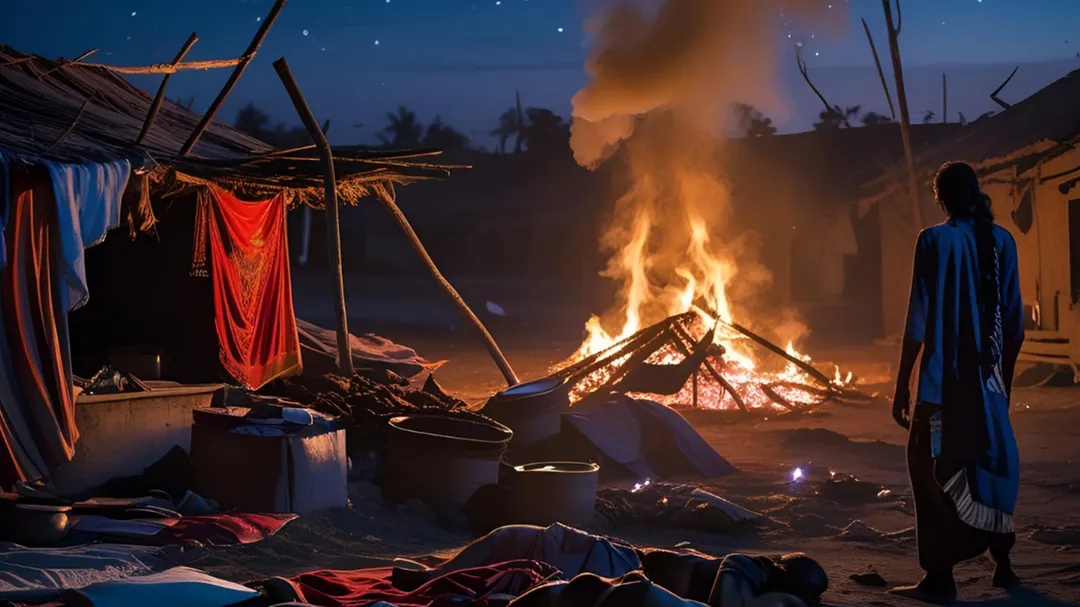The horrifying Bihar Witchcraft Violence that unfolded on July 6 has shocked the nation. Two back-to-back incidents in Purnia and Nalanda districts—linked by superstition, fear, and mob hysteria—have claimed the lives of seven people, including five from the same family. As authorities race to identify and arrest the culprits, the tragedy has drawn sharp criticism of Bihar’s crumbling law and order.
Purnia Horror: 5 Family Members Burnt Alive in Bihar Witchcraft Violence
In a terrifying turn of events in Purnia’s Titgaon village, five members of an Oraon tribal family were allegedly beaten and burned alive by a mob. The victims were targeted over accusations of practicing black magic—a deeply rooted superstition that continues to plague remote tribal regions.
The family members killed included:
- Babulal Oraon (father)
- Sita Devi (mother)
- Manjit Oraon (brother)
- Aranaia Devi (sister-in-law)
- Kakto (grandmother)
According to 16-year-old survivor Sonu Kumar, villagers dragged the victims out of their home, beat them brutally, and then set them on fire. The minor rushed to inform police around 5 AM, but by the time help arrived, it was too late. All five were found charred beyond recognition. The scene bore chilling evidence of what can happen when Bihar Witchcraft Violence goes unchecked.
Arrests and Police Action Following Bihar Witchcraft Violence
A First Information Report (FIR) has been filed against 23 named individuals and 150–200 unidentified villagers, suggesting that a large section of the community took part in this mob lynching. So far, three people have been arrested, including one minor.
The district administration, under Purnia DM Anshul Kumar, has completed post-mortems and last rites. Kumar confirmed that an SIT (Special Investigation Team) has been formed to ensure swift justice.
The local police, led by SDPO Pankaj Kumar Sharma, are aggressively investigating. They are recording statements from Sonu’s relatives, including a sister living in Virpur, and trying to identify a tractor and its owner used in the crime. The village, meanwhile, is eerily empty as many residents have fled fearing arrest or mob retaliation.
Family’s Anguish Amid Bihar Witchcraft Violence
Lalit Kumar, another son of the deceased, expressed grief and disbelief. He received a call from his brother during the attack, but couldn’t reach in time.
“My brother called me and said, ‘They are burning the family.’ When I arrived in the morning, everything was gone. My father, mother, brother, sister-in-law, and grandmother—they all were killed. The entire village did this.”
The trauma left behind by the Bihar Witchcraft Violence has scarred the family and tribal community deeply, with many now demanding protection and justice.
Political Reactions on Bihar Witchcraft Violence
The tragedy drew strong political reactions. BJP MLA Vijay Kemaka visited the site and called the massacre “tragic” and “shocking.” He affirmed that law enforcement will leave no stone unturned:
“The village was deserted when I arrived. The DIG, SP, DM were present. A tractor and its owner have been identified. No one will escape punishment.”
Union Minister Chirag Paswan added that the law and order situation in Bihar has “completely collapsed,” especially in light of the second violent incident on the same day in Nalanda.
Nalanda Tragedy: 2 Children Killed
In Dumrawan village, Nalanda, a violent clash between two groups led to the deaths of two children. Although not directly linked to the Purnia massacre, the incident heightened public concern over the state’s security failure. Activists fear that such events, including the Bihar Witchcraft Violence, reflect deep fractures in Bihar’s rural governance.
Why Witchcraft Accusations Still Persist in Bihar
Superstition remains deeply embedded in Bihar’s tribal and rural cultures. Accusations of witchcraft often arise:
- After unexplained deaths
- During outbreaks of illness
- In disputes over land or personal rivalries
In the Purnia case, the mob allegedly acted after a child from the Oraon community died three days earlier, prompting suspicions of black magic.
Experts point to the following root causes:
- Illiteracy and lack of scientific awareness
- Cultural myths passed through generations
- Poor rural policing
- Social stigmas against tribal women and elders
Such factors fuel brutal acts like the Bihar Witchcraft Violence, targeting already marginalized communities.
Legal, Social & Administrative Response to Bihar Witchcraft Violence
Legal Response:
- 23 accused named, 3 arrested
- 200+ villagers under investigation
- SIT formed for fast-tracked investigation
Social Action Needed:
- Community education on superstition and laws
- Outreach programs in tribal belts
- Mental health counseling for survivors
Administrative Action:
- Deployment of special police squads
- Surveillance and security in vulnerable villages
- Rehabilitation for affected families
Mental & Cultural Impact on the Community
The Bihar Witchcraft Violence has left a trail of fear and trauma. The Oraon community, already marginalized, is reeling from the attack. Many have left the village. Schools and local businesses remain shut. Women, particularly elders, are afraid to step outside, fearing wrongful accusations.

A tragic pattern emerges—victims are often women or elderly, accused arbitrarily, without proof or logic. Addressing this isn’t just about arrests—it’s about uprooting the superstitions that justify such violence.
What’s Next: Path to Justice and Prevention
- Judicial Fast-Tracking
- Expedite trials with SIT oversight
- Protect witnesses like Sonu
- State-Level Policy Reforms
- Strengthen anti-witch-hunt legislation
- Provide legal aid to victims
- Education Drives
- Organize local workshops
- Involve NGOs and tribal leaders
- Community Policing & Rehab
- Active police presence in remote villages
- Trauma support for families like Lalit Kumar’s
Bihar Witchcraft Violence Is a Wake-Up Call
The Purnia and Nalanda incidents are not isolated but part of a deeper issue of ignorance and lawlessness. The Bihar Witchcraft Violence is a painful reminder that without education, strong governance, and public awareness, rural communities remain vulnerable to mass hysteria and cruelty. Bihar must act fast to deliver justice—and prevent the next tragedy.
Bihar Election 2025 Countdown: Voter List Update Indicates October Date for Poll Schedule

